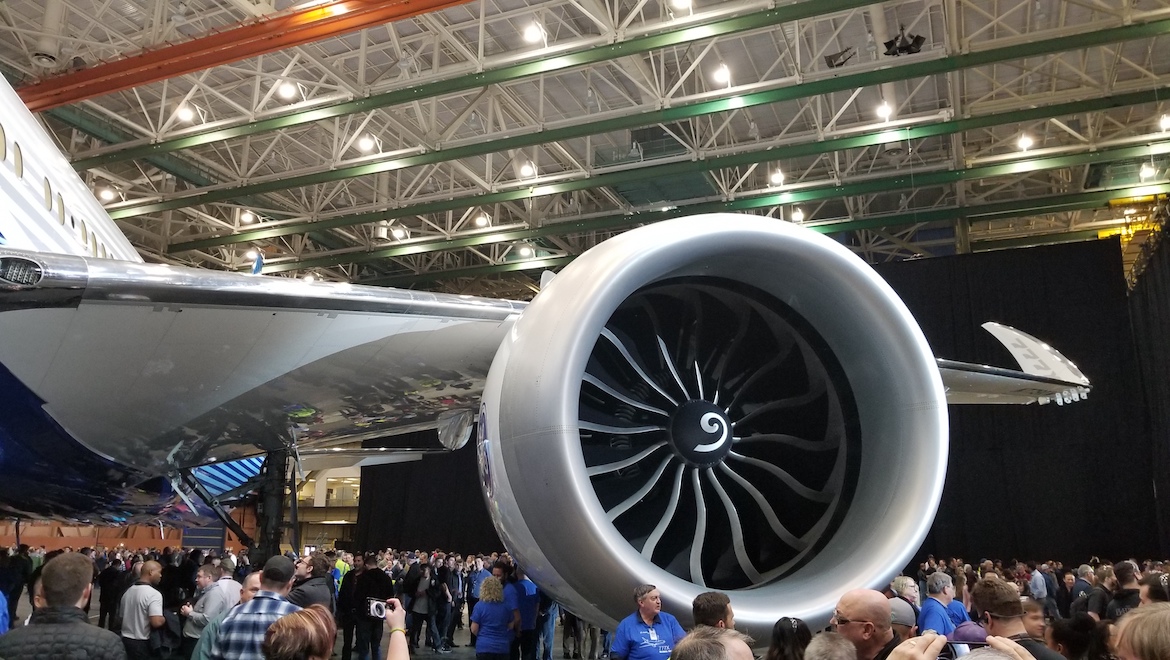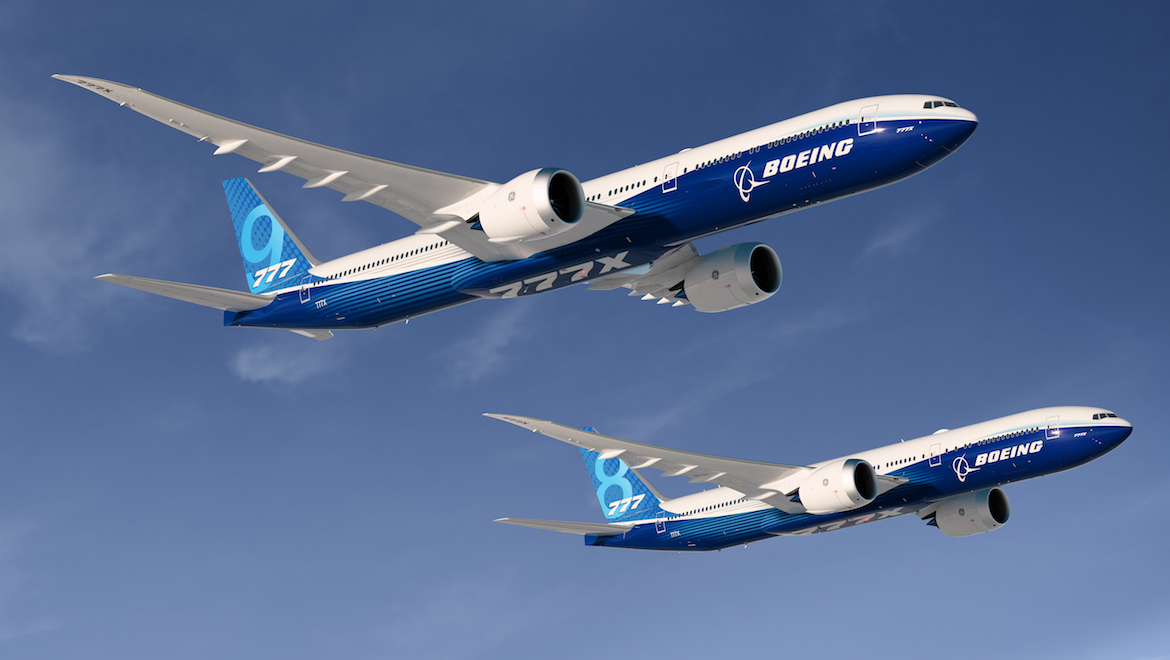
Boeing chief executive Dennis Muilenburg says first flight of the company’s 777-X program has been pushed back to early 2020 due to issues with the aircraft’s engines.
The delay was announced as part of Boeing’s second quarter results released on Wednesday (US time), which showed a net loss US$2.94 billion for the second quarter of calendar 2019.
Muilenburg said GE Aviation was working through “some challenges” with the GE9X engine that will power the 777-X family of aircraft.
“Based on GE’s latest assessment on what it will take to address these challenges, we are currently projecting that first flight will occur in early 2020 rather than in 2019 as we have previously mentioned,” Muilenburg told reporters and the financial community during Boeing’s second quarter results conference call.
“This scheduled flight is obviously disappointing given how well the aircraft has been performing in preflight tests and that we are on track on non-engine activities.”
Currently, Boeing has two 777-9X flight test aircraft being put through preflight tests. Muilenburg said the aircraft was preforming well, with intermediate gauntlet and initial taxi tests completed during the three months to June 30 2019.
Further, Boeing said the focus was currently on final systems, propulsion, and aircraft level tests.
https://www.facebook.com/Boeing/videos/450911565455572/
The manufacturer had been targeting a mid-2019 timeframe for first flight of the 777-X family of aircraft. However, issues with the engine’s compressor that emerged in recent times has forced Boeing to adjust the timetable.
While Boeing was still targeting 2020 for first delivery of the 777-9X – the first of two variants in the 777-X family of aircraft – Muilenburg said the challenges with the engine was “putting risk on the overall test schedule”.
“While we continue to target 2020 for first delivery of the 777-9 the engine issue has added significant risk to the schedule,” Muilenburg said.
“We continue to work closely with GE as well as explore opportunities to improve the schedule such as leveraging our system integration labs and additional airplane ground testing as we strive to meet this delivery target in a manner consistent with our commitment to safety.”
“We continue to expect 777 delivery rates to be approximately 3.5 aircraft per month in 2019. Given the pressure around 777X first delivery timeline, we are reassessing the 2020 skyline. In light of the strong demand for our freighter line, we intend to mitigate some of the impact by producing more 777 current-generation freighters in 2020.”

The 777-X is a two-aircraft family
Launched in 2013, the 777-X family of aircraft comprise the 777-8X and 777-9X variants. The pair is an upgrade from Boeing’s in-production 777-200LR and and 777-300ER.
In addition to the new GE Aviation GE9X engines, features of the 777-X family included composite wings with folding wingtips to maintain its Code E rating at airports, as well as in-cabin enhancements such as larger overhead stowage and a wider cross section.
The 777-9X is 77 metres in length and has a total wingspan of 72 metres with its wingtips extended. It is capable of flying 7,285nm when carrying 426 passengers in a two-class configuration, according to Boeing figures.

It has been pitched as the ideal replacement for the very large aircraft segment of the market, especially in light of Airbus’s decision to cancel the A380 program.
Boeing is also building the 777-8X, which is still in development. The Boeing website lists the aircraft as having a range of 8,690nm and a passenger capacity of 384 passengers in a two-class layout. The aircraft was expected to enter service in 2022.
The 777-8X was regarded as a potential replacement for the in-service Boeing 777-300ER. It is also a candidate for Qantas’s Project Sunrise challenge to Airbus and Boeing to have an aircraft capable of operating nonstop between Australia’s east coast and New York and London.

Airbus’s candidate is the A350 platform.
The 777-X program, which had received 344 orders at June 30 2019 according to the Boeing website, is up against the A350-1000 in the very large aircraft segment of the market.

Boeing aiming to submit 737 MAX final certification package by September
Meanwhile, Muilenburg said the company was continuing to address a software issue the United States Federal Aviation Administration (FAA) found when evaluating Boeing’s software fix for the grounded 737 MAX.
The Boeing chief executive described the issue as a specific condition of flight that was “unrelated” to the Maneuvering Characteristics Augmentation System (MCAS), an anti-stall software that has been implicated by investigators as a factor in fatal crashes of Ethiopian Airlines flight 302 and Lion Air flight 610 in March 2019 and October 2018, respectively.
“We agreed with the FAA’s decision and we are currently working on the software changes to address this requirement,” Muilenburg said.
“In addition, we are working with the FAA and other regulators to complete as many elements of the certification process as possible in parallel with the development of the software update.
“We will submit our final certification package to the FAA once we have satisfied all of their requirements, which we currently estimate will be in the September time frame.”
And while Boeing based its second quarter financial results on the assumption that regulatory approval in the United States and elsewhere would begin early in fourth quarter 2019, the company stressed the actual timing and conditions of the return to service of the 737 MAX would be determined by the regulatory authorities and could differ from its own forecasts.
“If any of the timeline assumptions change significantly from a start of the fourth quarter return to service, then we’ll have to evaluate alternatives,” Muilenburg said.
“And those alternatives could include different production rates. They could include a temporary shutdown of the line, not something we want to do, but an alternative that we have to prepare for, I think it’s a smart part of our thorough and disciplined process here to make sure we’re covering all scenarios.”
Muilenburg said Boeing was “working tirelessly” to meet the requirements of the FAA and other global aviation regulators.
“The process is dynamic and involves constant dialogue on outstanding questions and open issues that will continue in the days and weeks ahead,” Muilenburg said.
“We are committed to working with these regulators to satisfy all of the requirements and to ensure the 737 MAX’s safe return to service.”
Muilenburg said the company had conducted “a dozen customer conferences with MAX operators around the world and nearly 225 simulator sessions to develop test and demonstrate the software”.
“In addition, we conduct weekly technical calls with our customers worldwide to ensure that all the appropriate steps are being taken so that the fleet is fully prepared to return to service when the grounding is lifted,” Muilenburg said.

737 MAX grounding pushes Boeing to second quarter loss
The global grounding of the 737 MAX since March has taken a heavy toll on Boeing’s bottom line.
Boeing reported a net loss of US$2.94 billion for the three months to June 30 2019, slumping into the red from net profit of US$2.20 billion in the prior corresponding period.
Revenue fell 35 per cent to US$15.75 billion, Boeing said in a regulatory filing on Wednesday (US time).
It was the largest quarterly loss in the company’s history and the first quarterly loss in a decade.
The result was impacted by a previously announced after-tax charge of US$4.9 billion in relation to the grounding of the 737 MAX.
Boeing delivered 90 aircraft in the three months to June 30 2019, comprising 24 737s, two 747s, 10 767s, 12 777s and 42 787s. The total was less than half of the 194 deliveries achieved same quarter a year ago.
It was a much brighter picture at Boeing’s other two business units.
Boeing Defence, Space and Security posted an eight per cent increase in revenue to US$6.61 billion amid higher volumes across derivative aircraft, satellites, and weapons”. Earnings jumped 159 per cent to US$975 million.
“During the quarter, Defense, Space & Security received contracts for MH-47G Block II Chinook for the US Army Special Operations, F/A-18 service life modification for the US Navy, Joint Direct Attack Munition for the US Air Force, and Wideband Global Satellite Communication for the US Air Force,” Boeing said.
“Significant milestones achieved during the quarter included completion of the first T-X Trainer flight test on contract with the US Air Force and the final parachute test for the Commercial Crew spacecraft.”
Meanwhile, Boeing Global Services achieved an 11 per cent increase in revenue to US$4.54 billion, which was “primarily driven by the acquisition of Boeing Distribution Services, Inc. (formerly KLX) and higher international government services volume”. Earnings were up 14 per cent lift at US$687 million.
“During the quarter, Global Services was awarded Performance Based Logistics contracts for AH-64 Apache for the US Army and KC-767A Tanker for the Italian Air Force,” Boeing said.
“At the Paris Air Show, Global Services signed commitments with ASL Aviation Holdings and GECAS for up to 45 737-800 converted freighters and announced digital solution agreements with Delta Air Lines and JetBlue Airways.”
















Adrian P
says:An opportunity to look at the possibility of folding the wing tips down, so that when in flight the aerodynamic forces will hold the wing tips in place in event of a failure of the locking mechanism.
Pappy
says:Boeing’s folding wing technology and ‘know-how’ was inherited with the purchase of McDonnell Douglas and its US Navy carrier heritage dating back to WW2 and still current to today in the Super Hornets.
They’re electric, not hydraulic.
They’re quite simple in design with the sliding pin locking system.
Effectively two moving parts – the wing tip and the pins.
They don’t fail.
Ever.
Adrian P
says:Military aviation is a risky business as they are flown to the limit of the latest technology, military pilots accept this especially as they have ejector seats (secondary safety).
Civil aviation is about getting relatives safely to the destination.
McDonnell Douglas cargo doors DC10 could not fail, they did.
There are two types of safety, primary safety and secondary safety.
Primary safety is not having a failure in the first place, secondary safety is minimizing risk when it does go wrong.
What I am suggesting is secondary safety in event of a failure, the wing tip will remain in place, as an asymmetric failure would cause an to aircraft roll. I hope Pappy is right and I am wrong but aviation has historical debris from the failure of locking mechanisms.